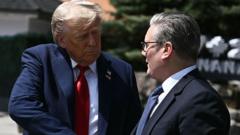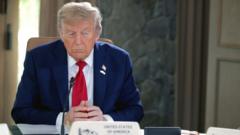The ongoing tariff negotiations between the Trump administration and the European Union have taken a sharp turn as President Trump threatens a massive tariff increase. This article explores the tensions arising from the U.S. approach that separates the negotiations from traditional ally dealings.
Trump's Tariff Threat: A Shift in U.S.-E.U. Trade Relations

Trump's Tariff Threat: A Shift in U.S.-E.U. Trade Relations
An analysis of President Trump's recent proposal for a 50% tariff on European imports, and its implications for U.S.-E.U. negotiations.
The transatlantic trade relationship, valued at nearly $5 billion in daily goods and services, faces new challenges as President Trump disrupts established negotiation protocols between the United States and the European Union.
In a surprising announcement via Truth Social, President Trump stated he would impose a staggering 50 percent tariff on European imports starting June 1. He claims that various European trade barriers and policies have created an "unacceptable" trade imbalance. "The European Union, formed primarily to take advantage of the United States on TRADE, has been very difficult to deal with," he remarked, emphasizing his frustration with the negotiation process.
For months, European officials have approached discussions in a manner befitting allies, seeking a collaborative resolution to prevent tariffs on critical sectors such as automobiles and pharmaceuticals. However, they find themselves negotiating with an administration that views this situation less as an opportunity for bilateral resolution and more as a chance to squeeze concessions from a trade competitor.
Throughout his presidency, Trump has enacted multiple rounds of tariffs on various sectors impacting the 27-member bloc, including steel, aluminum, and automobiles. Although he paused additional tariffs in April for a 90-day negotiation window, his latest remarks signal that the spirit of cooperation has waned and competition now underscores U.S.-E.U. relations.
The gap in perception and strategy around these negotiations marks a significant pivot in international trade dynamics, challenging long-held norms that have governed U.S.-E.U. trading practices. As tariff threats loom, both sides must navigate this complex terrain, or risk significant economic fallout.





















